Nikon 1 J4 Review
Nikon 1 J4 Introduction
The Nikon 1 J4 is the mid-level model in the Nikon 1 system of Mirrorless cameras. The system comprises of a electric lens-mount paired with a 3:2 aspect ratio sensor having a 2.7X crop factor. This makes it possible to shrink Nikon 1 cameras and lenses compared to all but one Mirrorless system.
Nikon developed a new 18 megapixels high-speed CMOS sensor, shared between the J4 and V3. The sensor features built-in Phase-Detect autofocus at 105 points and reads with a total of 171 points for Contrast-Detect autofocus, which allow AF coverage to the edge of the frame.
This high-speed CMOS sensor can shoot continuously at 60 FPS, with Single-Shot AF, or 20 FPS with Continuous AF, both at full resolution. An electronic-shutter allows fast shutter-speeds up to 1/16000s and down to 30s, plus Bulb exposures up to 2 minutes.
The Nikon 1 J4 is very compact for a mirrorless camera. Its body measures just 29mm thick, a specification that compares to ultra-compact cameras except that a lens needs to be added to use the J4. While it features full manual controls, its minimal number of external controls makes those time-consuming to use.
This detailed digital camera review takes a close look at the Nikon 1 J4's features, ergonomics, usability, image quality, performance and video recording features.
Nikon 1 J4 Features
Sensor
- 18 Megapixels High-Speed CMOS sensor
- 2.7X Crop factor, 3:2 aspect-ratio
- Nikon 1 lens mount
- Built-in Dust-Reduction
- JPEG, RAW or JPEG+RAW Output
Exposure
- Standard ISO 160 - 12800
- Special Noise-Reduction ISO 6400 & 12800
- Auto ISO with 800, 3200 or 6400 maximum
- PASM exposure modes, with Program-Shift
- 1/16000 - 30s Shutter-Speed, plus Bulb mode
- Multi-Segment, Center-Weighed and Spot metering
- Exposure-Compensation: ±3 EV in 1/3 EV steps
Image Parameters
- Automatic, 7 presetIncandescent, Fluorescent, Sunlight, Flash, Cloudy, Shade, Underwater and Custom white-balance.
- WB fine-tuning, 2 axis, 13 steps
- Sharpness, 10 levels or Auto
- Contrast, 7 levels or Auto
- Brightness, 3 levels
- Saturation, 7 levels or Auto
- Hue, 7 levels
- Optional High-ISO Noise-Reduction
- Optional Long-Shutter Noise-Reduction
- Optional Distortion Compensation
- Optional Active D-Lighting
- sRGB or Adobe RGB color-spaces
Drive & Focus
- AF-S, AF-C, MF and Auto Focus Drive
- Auto, Single or Tracking Focus Area
- 105-Point Phase-Detect autofocus
- 171-Point Contrast-Detect autofocus
- 60 FPS Continuous Drive with AF-S
- 20 FPS Continuous Drive with AF-C
- Self-Timer: 2s or 10s delay
Display
- 3” Touchscreen 3:2 LCD
- 1 Megapixels
- MF Assist, 1-10X
Video
- 1920x1080 @ 60 FPS 1080p HD video
- 1920x1080 @ 30 FPS 1080p HD video
- 1280x720 @ 60 FPS 720p HD video
- 1280x720 @ 30 FPS 720p HD video
- 1920x1080 @ 60 FPS Motion-Snapshot
- 1920x1080 @ 15 FPS Slow-Motion video
- 1280x720 @ 120 FPS High-Speed video
- 640x240 @ 400 FPS High-Speed video
- 320x120 @ 1200 FPS High-Speed video
- Stereo microphone, 3 levels or auto
- Optional Wind-Noise Reduction
Modes
- Built-in HDR
- Sweeping Panorama
- Best Moment Capture
- Motion Snapshot
Body & Controls
- Single Control-Dial
- Built-In WiFi
- Built-In flash
- AF-Assist lamp
- Lithium-Ion battery
- Micro SDXC memory slot
Nikon 1 J4 Usability - How easy is it to use?
Nikon took the chance to reinvent things with the introduction of their V1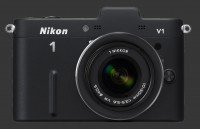
Nikon 1 V1 and J1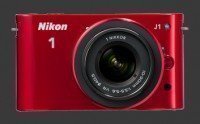
Nikon 1 J1 mirrorless and now refined things when they introduced the J3 and the new J4 is virtually identical in terms of interface. Overall, it is simple and easy to learn but it has some oddities.
The Nikon 1 J4 has a rectangular design. There is no hand-grip and the front of the camera is completely smooth, making it highly-recommended to use a strap. Nikon provides a color-matched neck-strap but, given the small size of the J4, a wrist-strap can easily be used instead.
The camera feels quite solid except for a flimsy battery and memory card compartment door. Supporting the 1 J4 from the lens, it has a nice weight without feel heavy at all. As with every ILC, this is the natural thing to do.
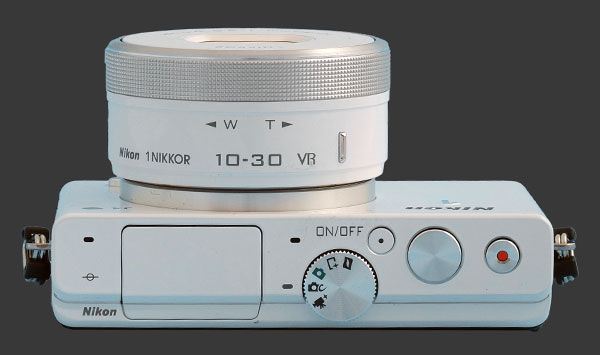
The top of the Nikon 1 J4 has a few simple controls. To the left is an unconventional mode-dial, like the one which appears on the back of the original J1. This one has 5 positions, exactly like on the J3 before it:
- Video mode is marked by the silhouette of a classic film camera. This lets the J4 shoot videos in any PASM mode with the obvious limitation that the shutter-speed cannot be set below the frame-rate.
- Creative mode is marked with a camera icon followed by a stylized letter C. This groups all PASM plus HDR, Easy Panorama and a number of Special Effects modes.
- Auto Image mode is marked by a green camera icon. This automatic mode leaves 4 user-controls available: EC, Motion Control, Background Softening and Active D-Lighting.
- Best Moment gives access to three modes which are unique to Nikon:
- Slow-View: Buffers up to 40 images in 1.3 seconds and plays them back in a loop while the shutter is pressed halfway. When the shutter is fully pressed, it saves the one image shown.
- Smart Photo Selector: Records a burst of images and saves the best one or five, depending on a menu option, according to sharpness and composition.
- Active Selection: This new mode records a burst of images and lets the photographer choose an image among them to save.
- Motion Snapshot takes a 16:9 aspect-ratio shot along with a one second slow motion video of the scene. One can choose video which preceded or surrounded the picture moment. Optional sound can be recorded from the scene or played from a fixed sound-track.
Slightly above the mode-dial is a small recessed power button which easily avoids accidental activation. With a collapsible lens, it is redundant as opening and closing the lens powers the camera on and off, respectively.
To its right is a standard two-stage shutter-release with short-travel and a soft halfway point. Next to it, there is a dedicated Video Record button. Pressing it records video in any mode but one cannot see correctly what is being recorded except in Video mode. The camera could have easily used one button for both functions according to the mode.
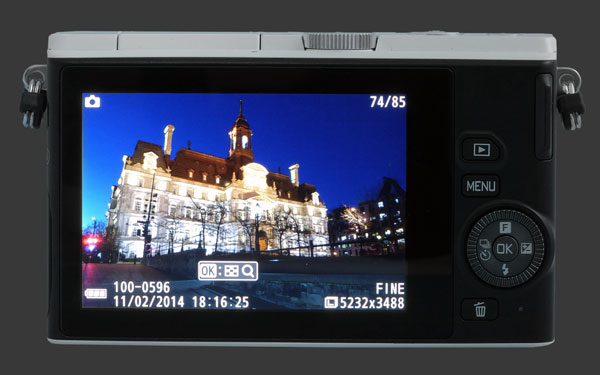
All remaining controls are found on the back of the Nikon 1 J4 which is dominated by a high-resolution 3" LCD with 1 megapixel. It shows 100% coverage unless Auto Distortion Control is enabled. It is unfortunately not Exposure-Priority and, oddly, the LCD does not consistently simulate WB correctly. The view if crisp with a good refresh rate. Visibility is reasonable but the preview is rather dark in low-light.
The LCD on the J4 is a touchscreen. Its sensitivity seems just right. By default, touching anywhere on the display focuses and releases the shutter. The menu can be easily navigated. In Playback mode, images can be advanced and zoomed in with standard gestures. There is a Function menu which cannot be completely worked by touch. It is probably a bug which can be fixed via firmware.
To the right of the LCD, there are three buttons which work just as expected: Playback, Menu and Delete. Delete does nothing in capture mode. There is also a 4-way controller with central OK button, surrounded by a very slim control-dial. Each button is assigned a function:
- Up invokes a small interactive control panel. The exact items which appear depend on the current mode. It can control the Mode, Shutter-Speed, Aperture, ISO, WB, Picture Control, Metering, Focus Mode and Focus Area.
- Right selects EC which is then adjusted ±3 EVs in 1/3 increments with the control-dial.
- Down is for Flash mode. Choices include On, Forced Redeye, Slow-Sync+Redeye, Slow-Sync and Slow Rear-Sync, depending on the mode.
- Left sets Drive mode. There are 7 options: Single-Shot, 10 FPS, 20 FPS, 30 FPS, 60 FPS, 10s, 2s. Self-timers annoyingly reset after each use.
- OK starts moving the focus-point. Press OK again to get back to normal.
The surrounding control-dial has soft detents and moves very easily. It sets the exposure parameter or the focus distance, depending on the camera mode. In M mode, using EC toggles between Aperture and Shutter-Speed. In MF mode, OK toggles between focus distance and exposure parameters. Note that Nikon 1 lenses do not have focus rings at this time.
For video - which we are grateful to see on any camera - the exact mode is then chosen via the menu. For HD capture, options are 1080p @ 60 FPS, 1080p @ 30 FPS, 720p @ 60 FPS or 720p @ 30 FPS. There are also slow-motion video at lower resolutions with frame-rates of 120, 400 and 1200 FPS.
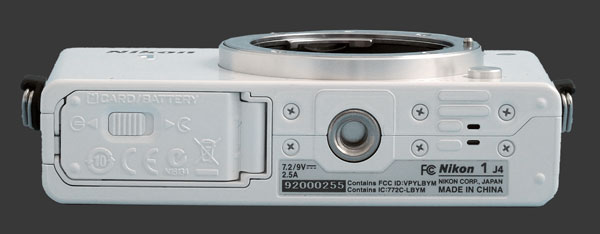
The bottom of the camera features a metal tripod, in-line with the optical center of the camera, plus a combined battery and memory compartment door. The door hides a Micro SDXC slot and a small battery.
Nikon 1 J4 Performance - How well does it take pictures?
Performance starts with image quality, which is the criteria used as the foundation of our digital camera ratings. Ergonomic issues may get in the way, but in the end, image quality counts the most. For an ILC, image quality greatly depends on the lens used. While color, noise, exposure and dynamic-range are properties of a camera, distortion, vignetting and chromatic aberrations are properties of the lens. Sharpness and contrast depend on the weakest link. That is, a camera cannot capture more details than a lens lets through. Conversely, it is possible for a lens to transmit more details than a sensor can capture.
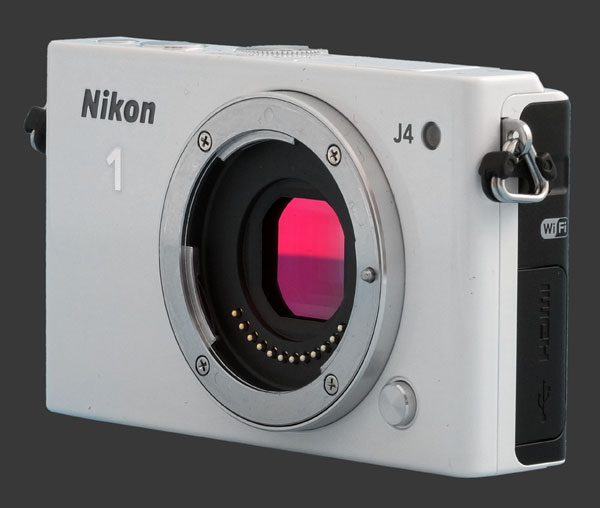
Image Noise & Details
The Nikon 1 J4 shows image-noise throughout its entire ISO range. From its base ISO of 160 to 400, noise is low. However, strong noise-reduction is also present which makes details appear soft at full-resolution. This limits print sizes to about half of what an 18 MP sensor should be capable of.
ISO 800 is slightly more noise and softer, further limited it use. Still, mid-size prints up to 12" x 8" are reasonably usable. ISO 1600 is not much worst and a mid-size print appears only slightly grainy. Blacks though are nowhere near black at that sensitivity.
By ISO 3200, noise is stronger which destroys details and severely impacts dynamic-range. One can pull off a small 4" x 6" print, no much more. ISO 6400 should be reserved for emergencies only, while ISO 12800 is best avoided entirely. With such a high-resolution sensor and modest size, it is difficult to expect better.
Sharpness on the J4 is adjustable in 10 levels. It starts at extremely soft and sharpens until there are severe artifacts. Still, images are never sharp due to rather aggressive noise-reduction. At slow shutter-speeds, the camera performs even more noise-reduction, so low-light performance is noticeably compromised.
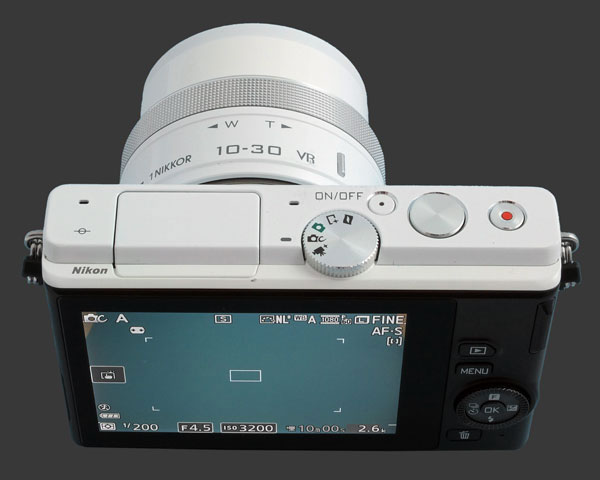
Color & White Balance
This digital camera performs reasonably in terms of colors. Neutral mode provides colors which resemble reality the most. There is a warm tone by default which is easily corrected by adding +1 to Hue. Default Contrast is good though.
The J4 has an average automatic white-balance system. AWB is tuned to produce slightly warm colors. It does occasionally fail to correct the strong color-cast of artificial light but not more than most. Custom while balance is good but not entirely perfect. For some reason though, the preview is sometimes completely wrong. This makes impossible to know when to change WB.
Exposure
The Nikon Matrix metering system used by the Nikon 1 J4 is exceptionally good. Exposure is quite consistent and accurate. Highlights are not blown out very often while results are generally bright enough to be usable as is. There is no Live-Histogram to preview exposure, nor is there an Exposure-Priority preview.
Auto Focus
The Nikon 1 J4 uses a fast hybrid autofocus system with both Phase-Detection and Contrast-Detection. Phase-Detection is done with 105 points right on the sensor, while Contrast-Detection is measured at 171 areas. This digital camera decides which one to use depending on available light.
Phase-Detection has the advantage of being faster and not needing back and forth lens movements to confirm focus. The latter point is particularly important during video which gets recorded as the camera focuses. When light is too low, the camera switches to Contrast-detection.
Autofocus speeds, because of the hybrid system, are variable. When light is good to moderately low, this Nikon focuses extremely quickly. Even under typical household lighting, this camera manages to lock focus faster than any mirrorless. As light levels drop and the camera switches to Contrast-Detection, things slow down gradually. When light is low, it still manages impressively well.
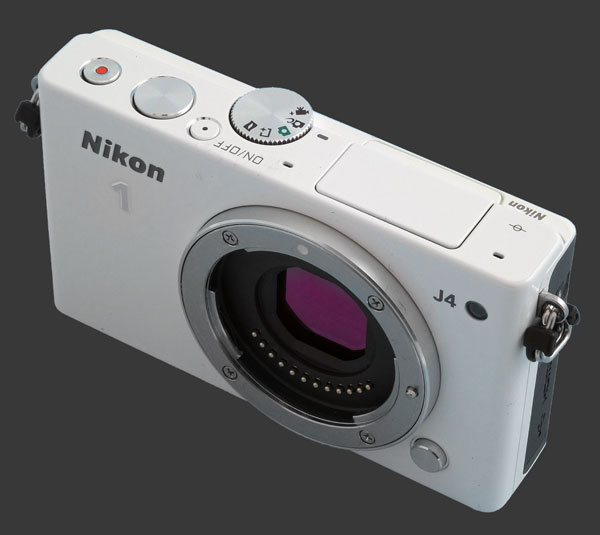
Speed
The Nikon 1 J4 is generally fast. Most controls gets an instant response, although there is a shutter-lag which was not observed on previous generations of Nikon 1 cameras. With Phase-Detection, autofocus even compares well to advanced DSLRs. This is a good performance for a mirrorless camera. These measurements characterize the performance of the J4:
- Power-On: 1½ seconds. Average.
- Power-On to First-Shot: 2 seconds. Good.
- Autofocus: Under ½s in good to moderate light. Rarely exceeds ¾s except in very low light. Very good.
- Shutter-lag: Perceptible but less than ¼s. Average.
- Blackout: None with Instant Review disabled. With it enabled though, there is ½s blackout.
- Shot-to-shot: Just over ½s. Excellent. Only with Instant Review disabled though.
- Video: Instant starting and stopping. Excellent.
- Playback: Instant to enter or exit. Excellent.
- Power-Off: Under ½s. Excellent.
This is not what was expected. Some aspects are improved over previous generations, while the ones most easily noticed are not. The main culprit is Instant Review which adds an unfortunate black-out and cripples shot-to-shot speeds. With Instant Review disabled, the speed of the Nikon 1 J4 is impressive.
The J4 fixes the video starting problems of the J3 which makes it immensely more usable. Under ideal conditions, the imperceptible shutter-lag and blackout are superb.
Battery-life of the Nikon 1 J4 is quoted at 300 shots-per-charge. This is below average, yet improved from the J3. It probably will not make it through a full day of shooting, so a second battery is recommended. During the review, it lasted nowhere close to that. In all likelihood, this is due to the power zoom lens which uses electricity to zoom, extend and collapse, on top of performing Vibration Reduction.
Nikon 1 J4 Conclusion
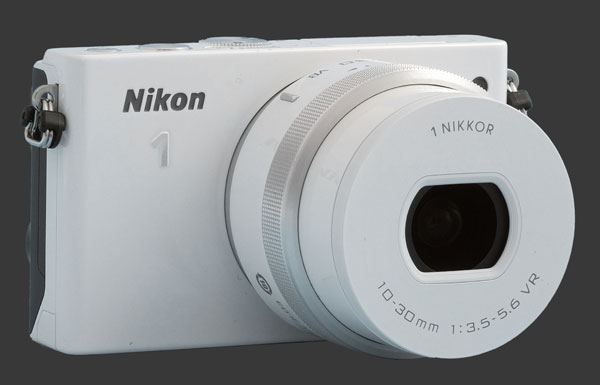
The Nikon 1 J4 is one of the rare cameras to perform at both extremes of the spectrum. Under the right conditions, it is impressively fast and ultra-quiet. The hybrid 171-area and 105-point autofocus system is something to behold. Although it slows down in low-light, as all cameras, it locks focus faster than most.
The high-speed CMOS sensor in this mirrorless is put to excellent use with 60 FPS full-resolution continuous drive and 1200 FPS high-speed video. The electronic shutter reaches an impressive 1/16000s which can freeze action better than most digital cameras.
Alas, image-quality lets the J4 down. There is noise present at all sensitivities with noise-reduction aggressively destroying details even at ISO 160. No matter which sharpness setting is chosen, images remain too soft and never fully usable at 18 megapixels. At best, it leaves the equivalent of 9 MP which is disappointing.
Metering though is good, considering the limited dynamic-range of this sensor. Colors and white-balance are also reasonable. Unfortunately, the lack of Exposure-Priority preview, Live-Histogram and even WB preview, make lots of images hit-or-miss.
The end result is that the Nikon 1 J4 must be carefully considered. Its compact size has been matched by digital cameras with larger sensors, yet its speed remains exceptional. There is no way to win on all fronts. The J3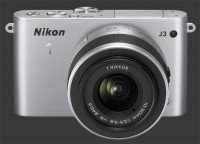
Nikon 1 J3 and V2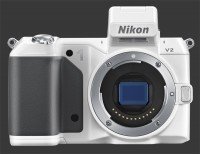
Nikon 1 V2 both do better though and should be preferred except for video.
 |
Please Support Neocamera
All information on Neocamera is provided free of charge yet running this website is a huge endeavor. Purchases made via affiliate links found throughout the site help keep it running and up-to-date. There is no additional cost to you, so please consider buying via these links to our affilates:
Thank you for your support!
Nikon J4 Highlights
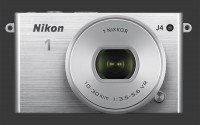
Sensor-Size: 13 x 9mm

Actual size when viewed at 100 DPI
| 18 Megapixels Mirrorless | ISO 160-12800 |
| Nikon 1 Mount 2.7X FLM | Shutter 1/16000-30s |
| 60 FPS Drive, Unlimited Images | Full manual controls, including Manual Focus |
| 1920x1080 @ 60 FPS Video Recording | Custom white-balance with 2 axis fine-tuning |
| 3" LCD 1 Megapixels | Spot-Metering |
| Lithium-Ion Battery | |
| Micro Secure Digital Extended Capacity |
Nikkor 10-30mm F/3.5-5.6 PD VR Lens
Nikon ships the 1 J4 with a electronic Nikkor 1 10-30mm F/3.5-5.6 PD-ZOOM VR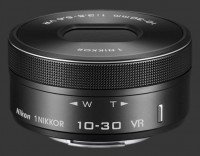
Nikkor 1 10-30mm F/3.5-5.6 PD-ZOOM VR lens. While its focal and aperture ranges are the same as those of the Nikkor 1 10-30mm F/3.5-5.6 VR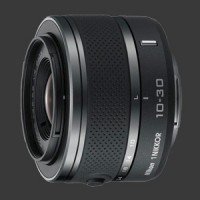
Nikkor 1 10-30mm F/3.5-5.6 VR, this new lens is quite different.
Considering the 2.7X crop-factor, this lens is equivalent to 27-81mm in 35mm terms. This is a wide to medium-range, similar to most kit-lenses sold with DSLRs.
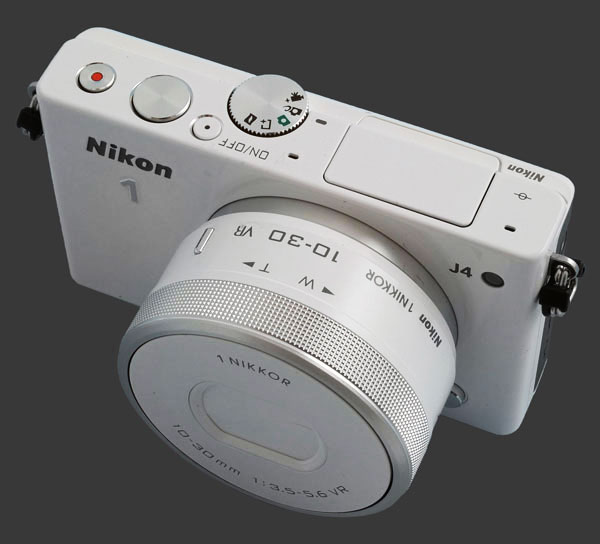
The novelty is that the PD-Zoom version included with the J4 works electronically and is self-capping. When the camera is powered-on, the lens opens and extends to its widest position.
From there, a fly-by-wire zoom-ring controls the focal-length in very fine increments. There is barely any lag while doing so either, producing one of the best electronic-zoom experiences of any power-zoom lens.
The design of the Nikkor 10-30mm F/3.5-5.6 PD-Zoom VR has two limitations: It accepts neither filter or lens hood. There is no lens cap to lose at least!

Optically, this lens is an entry-level performer. Sharpness is very reasonable in the center but quite soft on edges. Stopping down helps as usual but general softness due to diffraction takes hold quickly.
There is a high amount of barrel distortion at wide-angle. The camera can compensate for it partially but that makes framing very difficult since image edges have to be clipped out for the correction to work. Interestingly, it can also compensate for the reverse distortion underwater.
The lens vignettes with an easily noticeable darkening of corners near wide-angle. This improves towards telephoto. There is little sign of chromatic aberrations though.
Given its compact size, the Nikkor 10-30mm F/3.5-5.6 PD-Zoom VR lens is a good match for the Nikon 1 J4 which allows to keep total size small.
Updates
2025.11.13

Best Gifts for Photographers in 2025 by Budget
The annual Neocamera Photography Gift Guide updated to 2025. Find great gifts for photographers with any price budget.
2025.07.07

Stellar Photo Recovery Review
Review of Stellar Photo Recovery V12. This Windows and MacOS software can recover photos and videos in a huge number of formats from memory cards, USB drives, SSDs and HHDs.
2025.05.14

Huion Kamvas 13 Gen 3 Review
In-Depth review of the Huion Kamvas 13 Gen 3 Pen Display Tablet for photographers and graphic artists.
2025.01.18

Fujifilm GFX 2025 Lens Roundup
Lens Review roundup of Fujifilm GFX Medium-Format lenses. Quality, performance and handling of the GF20-35mm F/4R WR, GF30mm F/3.5 Tilt-Shift and the GF55mm F/1.7.
2024.11.18

Best 2024 Photography Gifts for Every Budget
Great gifts for photographers and photo enthusiasts selected for every budget among the best products of 2024.
2024.08.07

Eye Protection Tips for Professional Photographers
The four main considerations for professional photographers regarding eyewear.
2024.07.14

Fujifilm X100VI Review
Flagship fixed-lens compact digital camera with a 40 MP sensor and Image-Stabilization, a first for the series. Retro design featuring dual control-dials, plus direct ISO, Shutter-Speed and EC dials. Its hybrid viewfinder can switch between EVF and OVF mode.
2024.05.09

Fujifilm GFX100 II Review
Flagship 102 Megapixels Medium-Format Mirrorless Digital Camera with 8-Stop 5-Axis IBIS, 8 FPS Drive, 8K Video and 400 MP Super-Resolution capture in a weatherproof and freezeproof body with dual control-dials and dual memory-card slots.
2024.04.03

Fujifilm X-T5 Review
Newest Fujifilm flagship boasting a 40 MP APS-C sensor, 5-axis IBIS with 7-stop efficiency, 15 FPS continuous drive, 6.2K Video capture, dual control-dials and dual SDXC UHS-II slots in a sturdy weatherproof and freezeproof body.
2023.11.20

Best Digital Cameras of 2023
Find out which are the Best Digital Cameras of 2023. All the new Mirrorless Digital Cameras from entry-level to high-end professional.
2023.07.10

Fujifilm X-H2 Review
40 Megapixels APS-C Hybrid Mirrorless Digital Camera with 7-stop IBIS. Fastest shutter ever and 8K video capture. Large builtin EVF with 0.8X magnification and 5.8 MP, plus an Eye-Start Sensor. Packed with features and large number of controls in a weatherproof and freezeproof body.
2023.05.07

Sony FE 20-70mm F/4G Review
Review of the unique Sony FE 20-70mm F/4G lens. The optical zoom of this lens spans ultra-wide-angle and medium focal-length coverage, making it one of the most versatile Full-Frame lenses on the market.













